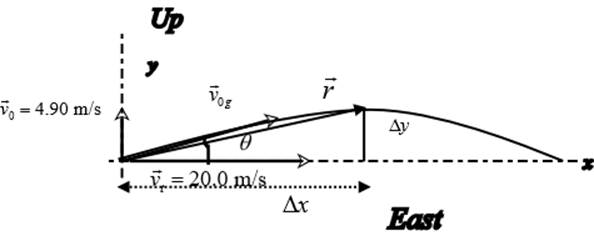
Concept explainers
(a)
The total time of flight of the ball as observed by the juggler in the train.
(a)
Answer to Problem 64P
The total time of flight of the ball as observed by the juggler in the train is found to be
Explanation of Solution
Given:
The initial velocity of the ball relative to the train
Formula used:
To determine the time of flight
Here,
Calculation:
The ball thrown in a train and the juggler are at rest with respect to the train. Choose a one dimensional coordinate system with the origin on the train and the positive y axis directed upwards. As the ball moves up and returns to the juggler’s hands, its displacement
Therefore,
Substitute these values in equation (1) and calculate the time of flight.
Conclusion:
Thus, the total time of flight of the ball as observed by the juggler in the train is found to be
(b)
The displacement of the ball during its rise as observed by the juggler.
(b)
Answer to Problem 64P
The displacement of the ball during its rise as observed by the juggler, is found to be
Explanation of Solution
Given:
The initial velocity of the ball relative to the train
Formula used:
To determine the displacement of the ball , the following equation of motion may be used.
Calculation:
As the ball moves upwards, it slows down due to the action of the Earth’s gravitational force. At the top most point of its trajectory, is instantaneous velocity v becomes zero.
Substitute the values of variables in the equation (2) and solve for
Conclusion:
Thus, the displacement of the ball during its rise as observed by the juggler, is found to be
(c)
The ball’s initial speed as observed by the friend on the ground.
(c)
Answer to Problem 64P
The ball’s initial speed as observed by the friend on the ground is found to be
Explanation of Solution
Given:
The initial velocity of the ball relative to the train
The velocity of the train relative to the ground
Formula used:
Using a coordinate system with the origin at the ground and the positive x axis along East, a vector diagram is constructed.

Figure 1
The person on the ground observes the ball to have a velocity
Calculation:
Substitute the values of variables in equation (3) and calculate the speed of the ball as observed by the person on the ground.
Conclusion:
Thus, the ball’s initial speed as observed by the friend on the ground is found to be
(d)
The angle of launch of the ball as observed by the person on the ground.
(d)
Answer to Problem 64P
The angle of launch of the ball as observed by the person on the ground
Explanation of Solution
Given:
The initial velocity of the ball relative to the train
The velocity of the train relative to the ground
Formula used:
Use Figure 1 to calculate the angle
Calculation:
Substitute the values of the variables in equation (4) and calculate the angle of launch of the ball as observed by the person on the ground.
Conclusion:
Thus, the angle of launch of the ball as observed by the person on the ground
(e)
The displacement of the ball during its rise as observed by the person on the ground.
(e)
Answer to Problem 64P
The displacement of the ball during its rise as observed by the person on the ground is found to be
Explanation of Solution
Given:
The initial velocity of the ball relative to the train
The velocity of the train relative to the ground
Formula used:
The displacement of the ball as seen by the person on the ground is given by the expression,
Here,
From Figure 1, it can be seen that the initial velocity
The time
The horizontal component of the ball’s velocity remains constant, since no force acts along the horizontal direction. While, since the acceleration of free fall acts downwards, the vertical component of the ball’s velocity varies with time.
The values of
Calculation:
The trajectory of the ball as seen by the person on the ground is shown in the diagram below;

At the top most point of its trajectory, the vertical component of the ball’s velocity becomes equal to zero. Use equation (7) and calculate the time taken by the ball to reach the top most point of its trajectory.
Calculate the value of
Calculate the value of
Substitute the values of
Conclusion:
Thus, the displacement of the ball during its rise as observed by the person on the ground is found to be
Want to see more full solutions like this?
Chapter 3 Solutions
EBK PHYSICS FOR SCIENTISTS AND ENGINEER
- person stands at the edge of a cliff and throws a pebble horizontally over the edge with a speed of v0 = 15.0 m/s.The pebble leaves his hand at a height of h = 46.0 mabove level ground at tge bottom of the cliff. How long (in s) after being released does the pebble strike the ground below the cliff?. With what speed (in m/s) and angle of impact (in degrees clockwise from the +x-axis) does the pebble land?arrow_forwardAn inquisitive physics student and mountain climber climbs a 51.0-m-high cliff that overhangs a calm pool of water. He throws two stones vertically downward, 1.00 s apart, and observes that they cause a single splash. The first stone has an initial speed of 2.06 m/s. (b) What initial velocity must the second stone have if the two stones are to hit the water simultaneously?arrow_forwardA clown juggle balls while doing other activities. In one act, she throws a ball vertically upward, and while it is in the air, she runs to and from a table 5.5 m away at constant speed of 2.5 m/s, returning just in time to catch the falling ball. With what minimum initial speed must she throw the ball upward to accomplish the act?arrow_forward
- A juggler throws a ball straight up into the air. If the ball returnsto its original position in the juggler’s hand in 0.98 s, what was itsmaximum height above the juggler’s hand?arrow_forwardA toy rocket moving vertically upward passes by a 1.8 m-high window whose sill is 7.0 mm above the ground. The rocket takes 0.16 ss to travel the 1.8 mm height of the window. a) What was the launch speed of the rocket? Assume the propellant is burned very quickly at blastoff. b) How high will the rocket go?arrow_forwardA particle trajectory is described by x= ( 0.7t -5. 7 t ) m, and y=(1t -4.4 t) m. where t is in seconds. red (1) what is the position of the particle at t = 4.2 s 3.0 tion (2) what is the velocity of the particle at t = 4.2 s )j m/s (3) What is the speed of the particle at t = 3 s m/s us page abus Summary Jump to...arrow_forward
- I throw a ball straight up in the air. It travels straight up 2 meters and then straight back down where I catch it at the same height it was released from. The distance the ball has traveled is meters. The displacement of the ball is meters. (use the proper number of sig figs in your answer given the provided information).arrow_forwardA flat-bed truck travels East on a highway at 80.0km/h. As the truck is moving, a cyclist is inside, pedaling at 4.5m/s [East] relative to the truck. The cyclist throws a banana peel backwards over his shoulder at 5.50m/s relative to himself. Determine the velocity of the banana peel relative to the highway. tyarrow_forwardA cyclist accelerates from rest along a straight, horizontal path for a time taccel = 14s at a rate of a = 1.3 m/s2. What is the magnitude of the displacement, in meters, for the cyclist during that time interval?arrow_forward
- The world long jump record is 8.95 m (Mike Powell, USA, 1991). Treated as a projectile, what is the maximum range, in meters, obtainable by a person if he or she has a take-off speed of 8.2 m/s? Assume the motion is over level ground and the initial velocity makes an angle of 45° with the horizontal.arrow_forwardBryan Allen pedaled a human-powered aircraft across the English Channel from the cliffs of Dover to Cap Gris-Nez on June 12, 1979. (a) He flew for 169 min at an average velocity of 3.53 m/s in a direction 45º south of east. What was his total displacement? (b) Allen encountered a headwind averaging 2.00 m/s almost precisely in the opposite direction of his motion relative to the Earth. What was his average velocity relative to the air? (c) What was his total displacement relative to the air mass?arrow_forwardAn inquisitive physics student and mountain climber climbs a 51.0-m-high cliff that overhangs a calm pool of water. He throws two stones vertically downward, 1.00 s apart, and observes that they cause a single splash. The first stone has an initial speed of 2.06 m/s. (a) How long after release of the first stone do the two stones hit the water?arrow_forward
 College PhysicsPhysicsISBN:9781305952300Author:Raymond A. Serway, Chris VuillePublisher:Cengage Learning
College PhysicsPhysicsISBN:9781305952300Author:Raymond A. Serway, Chris VuillePublisher:Cengage Learning University Physics (14th Edition)PhysicsISBN:9780133969290Author:Hugh D. Young, Roger A. FreedmanPublisher:PEARSON
University Physics (14th Edition)PhysicsISBN:9780133969290Author:Hugh D. Young, Roger A. FreedmanPublisher:PEARSON Introduction To Quantum MechanicsPhysicsISBN:9781107189638Author:Griffiths, David J., Schroeter, Darrell F.Publisher:Cambridge University Press
Introduction To Quantum MechanicsPhysicsISBN:9781107189638Author:Griffiths, David J., Schroeter, Darrell F.Publisher:Cambridge University Press Physics for Scientists and EngineersPhysicsISBN:9781337553278Author:Raymond A. Serway, John W. JewettPublisher:Cengage Learning
Physics for Scientists and EngineersPhysicsISBN:9781337553278Author:Raymond A. Serway, John W. JewettPublisher:Cengage Learning Lecture- Tutorials for Introductory AstronomyPhysicsISBN:9780321820464Author:Edward E. Prather, Tim P. Slater, Jeff P. Adams, Gina BrissendenPublisher:Addison-Wesley
Lecture- Tutorials for Introductory AstronomyPhysicsISBN:9780321820464Author:Edward E. Prather, Tim P. Slater, Jeff P. Adams, Gina BrissendenPublisher:Addison-Wesley College Physics: A Strategic Approach (4th Editio...PhysicsISBN:9780134609034Author:Randall D. Knight (Professor Emeritus), Brian Jones, Stuart FieldPublisher:PEARSON
College Physics: A Strategic Approach (4th Editio...PhysicsISBN:9780134609034Author:Randall D. Knight (Professor Emeritus), Brian Jones, Stuart FieldPublisher:PEARSON





